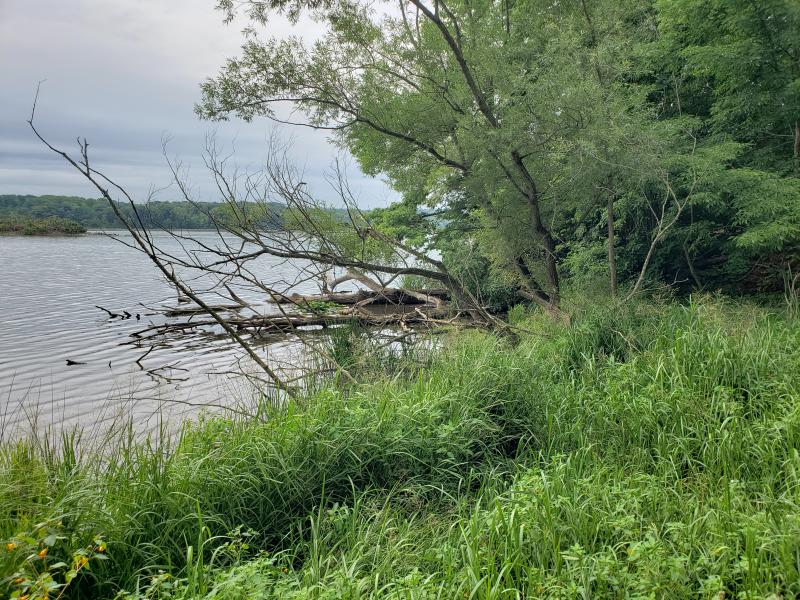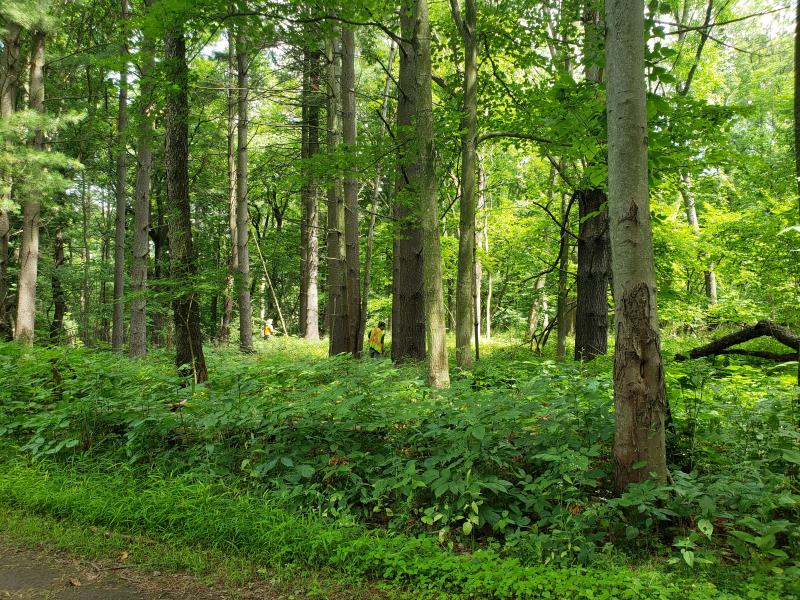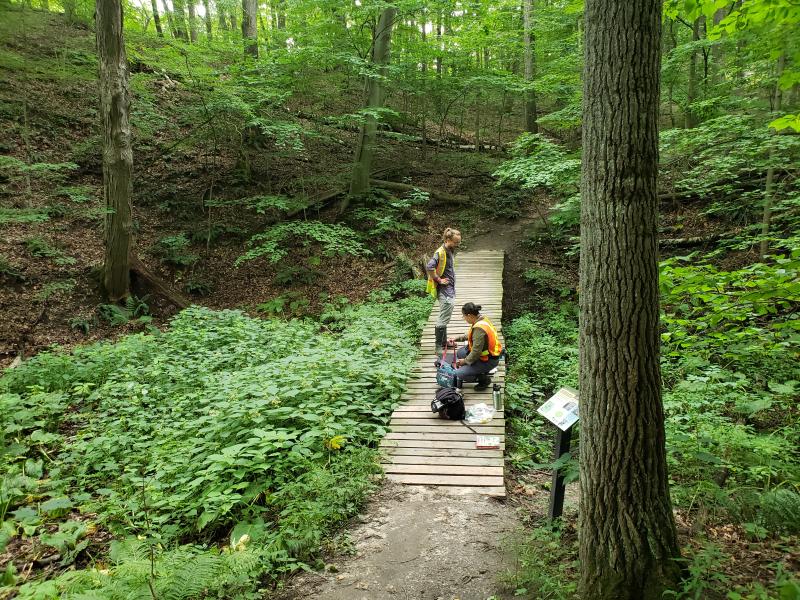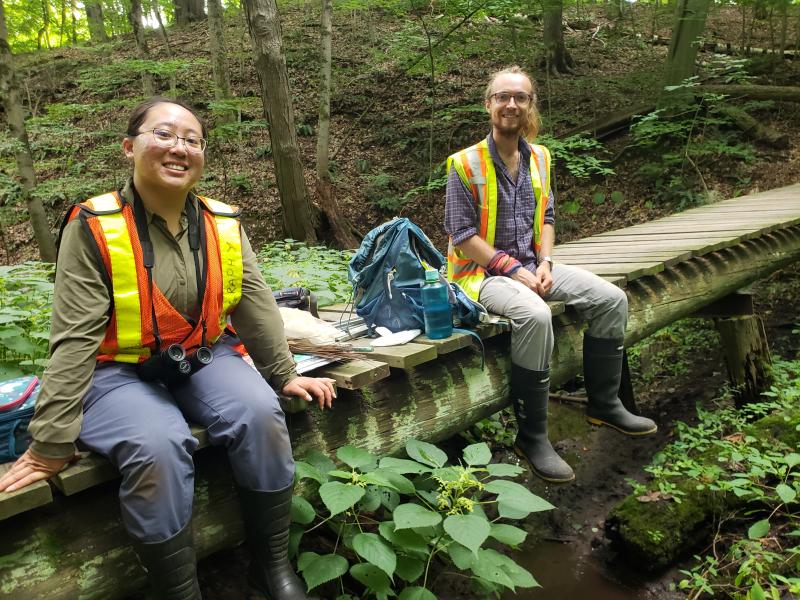
Tsi nón:we Ratinatsyayenthókwas “Where They Harvest Rice”
Cootes Oizhishi
Location
GPS Coordinates
Cootes Paradise is a 600-hectare nature sanctuary located on the Western tip of Lake Ontario and Burlington Bay, and is managed by the Royal Botanical Gardens. The sanctuary is composed of shallow open water marsh and several promontories that jut into the marshland. The marsh is naturally separated from Burlington Bay by a sandbar deposited during the Pleistocene glaciation, and which makes up Burlington heights today. At the confluence of Lake Ontario, Dundas valley and the Niagara escarpment, Cootes Paradise is a biodiversity hotspot in southern Ontario; it is an important stopover point for migratory birds, and the marshland is an important nursery for many Lake Ontario fish species. The nature sanctuary is home to an arboretum with native and horticultural tree collections, a nature interpretation center, and a series of trails, including an interpretative trail showcasing Anishinaabe medicinal plants.
Straddling the Carolinean and Great Lakes – St. Lawrence forest zones, Cootes Paradise has a diversity of flora, including 1197 documented species, but also faces challenges from invasive species, such as garlic mustard, buckthorn, multiflora rose, and dog-strangling vine. The majority of the shallow marsh is dominated by emergent cattails, while marsh edges are home to a diversity of wetland herbaceous species such as joe-pye weed, boneset, swamp milkweed, nettles, pickerelweed, and purple loosestrife, and shrubs, such as willows, alders, dogwoods and buttonbush. On higher ground, promontories support rich deciduous forests composed of a mix of red maple, ironwood, birch, ash, and black cherry. Common shrubs include witch-hazel, blue beech, honey-suckles and viburnums, and in some places, paw-paw seedlings can be seen growing in the forest’s understory. The southern shore of Cootes Paradise marsh is home to rare forest assemblages, including patches of old white oaks and dense sassafras stands.
Human activity in Cootes Paradise spans 9000 BCE to the present day. The earliest pieces of evidence of human presence consist of scattered stone tools dating from the Archaic period, from 9000-8000 BCE and 2000-1500 BCE. There is evidence of several campsites on the margins of the marshland that date back to the Middle Woodland period (200 BCE to 500 CE). Archaeologists excavated an abundance of ceramic vessels at these campsites, which they estimate were used to store wild rice. Archaeologists interpret these camps as seasonal settlements for the purposes of harvesting wild rice and other resources from the marsh. Although Cootes Paradise marsh is currently dominated by cattails, analysis of pollen deposits from sediment cores shows that prior to 1200 CE, wild rice was the dominant wetland plant.
Archaeologists found preserved maize kernels at Princess Point, a large promontory on the southern shore of Cootes Paradise that date to 500 CE. The maize found at this site is a descendant of maize varieties that were initially cultivated in meso-America at ~4000 BCE, and significantly, is the earliest material evidence of agriculture in all of Canada. Concurrently, use and settlement of Cootes Paradise intensified. Archaeologists hypothesize that maize production initially occurred at small scales to supplement wild harvesting in foodways, but over time, their ability to expand agriculture at Princess Point allowed them to create permanent settlements there. The period of heaviest population of Cootes Paradise during the Middle/Late Woodland period occurred from 500-1000 CE, and archaeologists refer to people who were living here then as the Princess Point culture. The Princess Point culture were maize agriculturalists whose sites spanned a 100 km radius around the Burlington area, and were the ancestors of contemporary Iroquoian and Algonquian cultures.
From 1000 CE onward, these Indigenous populations moved from the Princess Point location inland, to establish several permanent agricultural villages ~10 km north of Cootes Paradise. By 1100 CE, they no longer built permanent settlements at Cootes Paradise. However, the marsh remained an important site for hunting, fishing, harvesting, and other resource harvesting activities, and served as an important seasonal meeting place and crossroads between Indigenous peoples. Cootes Paradise marsh lies at the Eastern end of the Head of the Lake portage, an Indigenous trail and land route that connected Burlington Bay to the Grand River; thus, the marsh facilitated travel. From the Late Woodland period to the beginnings of European settlement in the region, Burlington Bay and Cootes Paradise were the homelands of the Attiwandaron/Neutral Nation who continued to live in, use and traverse the area extensively. By the 1650s, political, economic, and military conflict precipitated demographic shifts that brought Haudenosaunee and Anishinaabe peoples more extensively into the area, and they also built relationships with the unique environments of Cootes Paradise.
Galbraith, David. “The Gardens and the marsh: the Fascinating Story of Cootes Paradise,” a lecture by Head of Science RBG Hamilton, 17/10/2017, found online at: Another Drop Lecture - The Garden And The Marsh: The Fascinating Story Of Cootes Paradise - YouTube
Johnson, Lorraine. 2007. The Natural Treasures of Carolinian Canada: Discovering the Rich Natural Diversity of Ontario’s Southwestern Heartland. Carolinian Canada Coalition.
Kelly, Peter E. and Larson, Doug. 2007. The Last Stand: A Journey Through the Ancient Cliff-face Forest of the Niagara Escarpment. Natural Heritage Books.
Smith, David G. and Haines, Helen R., Galbraith, David, and Theysmeyer, Thys. 2011. The Point of Popularity: A Summary of Human Activity at the Princess Point Promentory, Cootes Paradise Marsh, Hamilton, Ontario. In Canadian Journal of Archaeology. 25: 232- 257. Found at: The Point of Popularity: A Summary of Human Activity at the Princess Point Promentory | Helen R Haines and David G. Smith - Academia.edu
| English | Latin | Kanienʼkéha | Anishinaabemowin |
|---|---|---|---|
| Pawpaw | Asimina triloba | (check this) | (check this) |
| Bitternut Hickory | Carya cordiformis | o’nón:na, ontsí:kahwe, yohso'kwatskà:rat | mitigwaabaak (-ook, plural) |
| Green Ash | Fraxinus pennsylvanica | kaneróhon | emikwaansaak, aagimaak, bwoyaak |
| Mayapple | Podophyllum peltatum L. | onénhotst, onénhotste, kawérhos | zhaabozigan (-an, plural), ininiwijiibik |
| Red Maple | Acer rubrum | ka’takén:ra | zhiigmewanzh, zhiishiigimiiwanzh (-iik, plural) |
| Sugar Maple | Acer saccharum | wáhta’, ohwáhta | ininaatik, ininaatig (-oog, plural) |
| White Snakeroot | Ageratina altissima | teyohontáthe | bi'jikiw'ack |
| Common Serviceberry | Amelanchier arborea | ohrá:ton | gozigwaakomiinagaawanzh, gazigwa'kominaga'wan |
| Burdock | Arctium lappa | ohrohte’kó:wa | zagdebwe, zadebwe |
| Jack-in-the-pulpit | Arisaema triphyllum | tyehnónhserote, kyehnónserote, kárhon, tsyorákares, tsorákares, kahnéhserote, okwá:rot nikarhonksherá:'a | zhaashaagomin |
| Pawpaw | Asimina triloba | (check this) | (check this) |
| Yellow Birch | Betula alleghaniensis | tsyotsyó:ren | wiinizik (-oog, plural) |
| Musclewood | Carpinus caroliniana | yotenakaratí:wen | Ska’ agon-mins, Shka agonmins |
| Bitternut Hickory | Carya cordiformis | o’nón:na, ontsí:kahwe, yohso'kwatskà:rat | mitigwaabaak (-ook, plural) |
| Pignut Hickory | Carya glabra | (check this) | mitigwaabaak (-ook, plural) |
| Alternate-leaf Dogwood | Cornus alternifolia | teyotsí:tsayen | moozwemizh, moozomizh, niibiishan miskwaabiimizhiig |
| Gray Dogwood | Cornus racemosa | tsítyete | mazh’omizh |
| Intermediate Wood Fern | Dryopteris intermedia | yetskarónhkwa, onitskerónhkwa, yetskaronhkwa'kó:wa | naanaaganashk (-oon), mzise miijim |
| Trout Lily | Erythronium americanum | skatsihstóhkonte | namegbagoniin |
| Large-leaved Aster | Eurybia macrophylla | teyonerahtawe'éhston, orón:ya yotiron’onhkóhare, iotsiron'onhkóhare oròn:ia, yako’tonhkwárhos onónhkwa, iako'tonhkwáhrhos onónhkwa | migiziwibag |
| Joe Pye Weed | Eutrochium maculatum | tewaten'én:yaya'ks | meskwaagamesek, me'skwana'kak, ba'giso'wan |
| Boneset | Eupatorium perfoliatum | teyonerahtawe’éhston | niya'wibwakak (plural) |
| Woodland Strawberry | Fragaria vesca L. | ken’niiohontesha, niyohentéhsha’, niyohontéhsa, ken’niyohontésha | odeimin (-an, plural) |
| Wild Strawberry | Fragaria virginiana Duchesne | ken’niiohontesha, niyohentéhsha’, niyohontéhsa, ken’niyohontésha | odeimin (-an, plural) |
| Green Ash | Fraxinus pennsylvanica | kaneróhon | emikwaansaak, aagimaak, bwoyaak |
| Witch Hazel | Hamamelis virginiana | takwa’aserón:ni | nsakemizins |
| Round-lobed hepatica | Hepatica Americana | kontirontá:non, karón:tanonhne | gabisan’ikeag, a'nima'sid |
| Partridge Berry | Mitchella repens | ohkwé:sen aonáhi | binemiin, bine(wi)min |
| Ghost pipe | Monotropa uniflora | yononnawen'tòn:ton, kanonnawen’tsherahrèn:ton | (check this) |
| Red Mulberry | Morus rubra | yotská:rare | (check this) |
| White Lettuce | Nabalus albus | ó:nyare aonón:tsi | dado’chabodji’bik |
| Ironwood | Ostrya virginiana | tysoráhsa | maananohns, maananoons (-ak, plural) |
| Virginia Creeper | Parthenocissus quinquefolia | kontiráthens | mnidoo- biimaakwad bebaamooded |
| White Pine | Pinus strobus | tyonerahtase'kó:wa, onehta'kó:wa, ohnehta’kó:wah | biisaandago-zhingwaak, zhingwaak, shingwaak |
| Mayapple | Podophyllum peltatum L. | onénhotst, onénhotste, kawérhos | zhaabozigan (-an, plural), ininiwijiibik |
| Christmas Fern | Polystichum acrostichoides | tsyenhá:ken | (check this) |
| Trembling Aspen | Populus tremuloides | onerahtón:ta, o’nerahtón:ta, orahaton takorokwa | azaadi, azaadiins, azaadiins, azaadiig, zaad, zaat |
| Black Cherry | Prunus serotina | é:ri, e:ri’kó:wa, tyotyò:ren | ookweminagaawanzh, ookweminan, ikwe'mic |
| Chokecherry | Prunus virginiana | tyakonya’tawén:’eks, teyakonya’tawén:’eks | asasaweminagaawanzh, asasaweminan, baakinminaan, asasaweminogaawangh |
| White Oak | Quercus alba | otokénha | mitigomizh (-iik, plural) |
| Prickly Gooseberry | Ribes cynosbati | tyorenatsí:yo, ohrá:ton, anáduma:o:náhi | zhaabo-miinashkoon, zhaaboomin (-aak, plural), me’skwacabo’minak, kaawe-saba, Zhaaboominagaawanzh/iig "going through/piercing berr plant/s or shrub/s" |
| Swamp Gooseberry | Ribes hirtellum | tyorenatsí:yo, ohrá:ton, anáduma:o:náhi | zhaabo-miinashkoon, zhaaboomin (-aak, plural), me’skwacabo’minak, kaawe-saba |
| Carolina Rose | Rosa carolina | yako’tanentáktha, teyohnyonwarón:ton | oginiiwaatik, gaawaak-bagoohnseak |
| Allegheny Blackberry | Rubus allegheniensis | sá:yase | odatagaagominag |
| Common Dewberry | Rubus flagellaris | sá:yase | odatagaagominag |
| Red Raspberry | Rubus idaeus | skanekwen’terá:yen, skanekwen’terá:ne, skanekwenhtará:nenh | miskomin (-ak, plural) |
| Sassafras | Sassafras albidum | wenhnákeras | menaagwaakmizh, menagwake miins |
| Tall goldenrod | Solidago altissima | otsí:nekwar niyotsi’tsyò:ten | ajidamoowaanow, waabanoominens/waabanoominensag, giizisso mashkiaki |
| Blue-stemmed Goldenrod | Solidago caesia | otsí:nekwar niyotsi’tsyò:ten | ajidamoowaanow, waabanoominens/waabanoominensag, giizisso mashkiaki |
| Canada Goldenrod | Solidago canadensis | otsí:nekwar niyotsi’tsyò:ten | ajidamoowaanow, waabanoominens/waabanoominensag, giizisso mashkiaki |
| New England Aster | Symphyotrichum novae-angliae | teyonerahtawe'éhston, yotsiron’onhkóhare orón:ya | waanisikensiwang |
| Calico Aster | Symphyotrichum lateriflorum | teyonerahtawe'éhston, yotsiron’onhkóhare orón:ya | name'gosiibag |
| Dandelion | Taraxacum officinale | tekaronhyaká:nere | mindemoyanag, doodooshaaboojiibik, mindimooyenh, wezaawaaskwaneg |
| Early Meadow Rue | Thalictrum dioicum | otsi’tsyakérha | (check this) |
| Poison Ivy | Toxicodendron radicans | yakohón:taras, yakohontaráhstha, wate’nenharì:sere, yakohén:tara’s | nimkiibak |
| White Trillium | Trillium grandiflorum | tsyonatsyakén:ra niyotsi’tsyò:ten, tsyoná:tsik, áhsen niioneráhtonte | ininiiwindibiigegan, baashkindjibgwaan, baushkindjibgwaun, ini'niwin'digige'gun |
| Maple-leaf Viburnum | Viburnum acerifolium | karhata’kéha | miinan |
| Common Blue Violet | Viola sororia | tekonnyarotárhoks, tekonteniarotáhrhoks, tewatenyarotárhos | we-waawiyeyaa-bagak, wewaie’bagag, ozhaawashkwaabigwan "blue or green flower/s) |
| Wild Grape | Vitis riparia | o’nénhare | zhoominan, jo’minaga’wanj |



